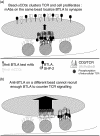Monoclonal antibodies to B and T lymphocyte attenuator (BTLA) have no effect on in vitro B cell proliferation and act to inhibit in vitro T cell proliferation when presented in a cis, but not trans, format relative to the activating stimulus
- PMID: 21078085
- PMCID: PMC3010914
- DOI: 10.1111/j.1365-2249.2010.04259.x
Monoclonal antibodies to B and T lymphocyte attenuator (BTLA) have no effect on in vitro B cell proliferation and act to inhibit in vitro T cell proliferation when presented in a cis, but not trans, format relative to the activating stimulus
Abstract
B and T lymphocyte attenuator (BTLA) is an immunoglobulin superfamily member surface protein expressed on B and T cells. Its ligand, herpesvirus entry mediator (HVEM), is believed to act as a monomeric agonist that signals via the CRD1 of HVEM to inhibit lymphocyte activation: HVEM is also the receptor for lymphotoxin-α and LIGHT, which both bind in the CRD2 and CRD3 domains of the HVEM molecule, and for CD160 which competes with BTLA. We have shown that recombinant HVEM and a panel of different monoclonal antibodies specifically bind murine BTLA on both B and T cells and that some antibodies inhibit anti-CD3ε-induced T cell proliferation in vitro, but only when constrained appropriately with a putatively cross-linking reagent. The antibodies had no significant effect on in vitro T cell proliferation in a mixed lymphocyte reaction (MLR) assay nor on in vitro DO11.10 antigen-induced T cell proliferation. None of these antibodies, nor HVEM-Fc, had any significant effect on in vitro B cell proliferation induced by anti-immunoglobulin M antibodies (±anti-CD40) or lipopolysaccharide. We further elucidated the requirements for inhibition of in vitro T cell proliferation using a beads-based system to demonstrate that the antibodies that inhibited T cell proliferation in vitro were required to be presented to the T cell in a cis, and not trans, format relative to the anti-CD3ε stimulus. We also found that antibodies that inhibited T cell proliferation in vitro had no significant effect on the antibody captured interleukin-2 associated with the in vivo activation of DO11.10 T cells transferred to syngeneic recipient BALB/c mice. These data suggest that there may be specific structural requirements for the BTLA molecule to exert its effect on lymphocyte activation and proliferation.
© 2010 Authors. Clinical and Experimental Immunology © 2010 British Society for Immunology.
Figures





Similar articles
-
The CD160, BTLA, LIGHT/HVEM pathway: a bidirectional switch regulating T-cell activation.Immunol Rev. 2009 May;229(1):244-58. doi: 10.1111/j.1600-065X.2009.00783.x. Immunol Rev. 2009. PMID: 19426226 Review.
-
A herpesvirus entry mediator mutein with selective agonist action for the inhibitory receptor B and T lymphocyte attenuator.J Biol Chem. 2017 Dec 22;292(51):21060-21070. doi: 10.1074/jbc.M117.813295. Epub 2017 Oct 23. J Biol Chem. 2017. PMID: 29061848 Free PMC article.
-
T cell intrinsic heterodimeric complexes between HVEM and BTLA determine receptivity to the surrounding microenvironment.J Immunol. 2009 Dec 1;183(11):7286-96. doi: 10.4049/jimmunol.0902490. Epub 2009 Nov 13. J Immunol. 2009. PMID: 19915044 Free PMC article.
-
Unconventional ligand activation of herpesvirus entry mediator signals cell survival.Proc Natl Acad Sci U S A. 2009 Apr 14;106(15):6244-9. doi: 10.1073/pnas.0902115106. Epub 2009 Mar 30. Proc Natl Acad Sci U S A. 2009. PMID: 19332782 Free PMC article.
-
The signaling networks of the herpesvirus entry mediator (TNFRSF14) in immune regulation.Immunol Rev. 2011 Nov;244(1):169-87. doi: 10.1111/j.1600-065X.2011.01064.x. Immunol Rev. 2011. PMID: 22017438 Free PMC article. Review.
Cited by
-
Roles of BTLA in Immunity and Immune Disorders.Front Immunol. 2021 Mar 29;12:654960. doi: 10.3389/fimmu.2021.654960. eCollection 2021. Front Immunol. 2021. PMID: 33859648 Free PMC article. Review.
-
Checkpoint inhibitors: What gastroenterologists need to know.World J Gastroenterol. 2018 Dec 28;24(48):5433-5438. doi: 10.3748/wjg.v24.i48.5433. World J Gastroenterol. 2018. PMID: 30622372 Free PMC article. Review.
-
The Co-inhibitor BTLA Is Functional in ANCA-Associated Vasculitis and Suppresses Th17 Cells.Front Immunol. 2019 Dec 10;10:2843. doi: 10.3389/fimmu.2019.02843. eCollection 2019. Front Immunol. 2019. PMID: 31921121 Free PMC article.
-
Herpesvirus Entry Mediator and Ocular Herpesvirus Infection: More than Meets the Eye.J Virol. 2017 Jun 9;91(13):e00115-17. doi: 10.1128/JVI.00115-17. Print 2017 Jul 1. J Virol. 2017. PMID: 28404853 Free PMC article. Review.
-
BTLA Expression and Function Are Impaired on SLE B Cells.Front Immunol. 2021 Apr 22;12:667991. doi: 10.3389/fimmu.2021.667991. eCollection 2021. Front Immunol. 2021. PMID: 33968071 Free PMC article.
References
-
- Gavrieli M, Watanabe N, Loftin SK, Murphy TL, Murphy KM. Characterization of phosphotyrosine binding motifs in the cytoplasmic domain of B and T lymphocyte attenuator required for association with protein tyrosine phosphatases SHP-1 and SHP-2. Biochem Biophys Res Commun. 2003;312:1236–43. - PubMed
-
- Hurchla MA, Sedy JR, Drake CG, Murphy KM. B and T lymphocytle attenuator (BTLA) exhibits structural and expression polymorphisms and is highly Induced in anergic CD4+ T cells. J Immunol. 2005;174:3377–85. - PubMed
-
- Compaan DM, Gonzalez LC, Tom I, Loyet KM, Eaton D, Hymowitz SG. Attenuating lymphocyte activity – the crystal structure of the BTLA–HVEM complex. J Biol Chem. 2005;280:39553–61. - PubMed
-
- Hurchla MA, Sedy JR, Murphy KM. Unexpected role of B and T lymphocyte attenuator in sustaining cell survival during chronic allostimulation. J Immunol. 2007;178:6073–82. - PubMed
-
- Chemnitz JM, Lanfranco AR, Braunstein I, Riley JL. B and T lymphocyte attenuator-mediated signal transduction provides a potent inhibitory signal to primary human CD4 T cells that can be initiated by multiple phosphotyrosine motifs. J Immunol. 2006;176:6603–14. - PubMed
MeSH terms
Substances
LinkOut - more resources
Full Text Sources
Other Literature Sources
Research Materials

